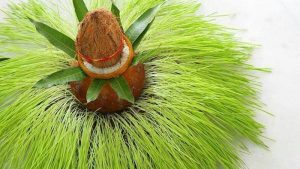Ghaṭasthāpanā

Day One
Durga is worshipped in 10 forms/incarnations during the first 10 days of Dashain – 1 form for each day of her 10 day long battle with the demon Mahishasaura. Yesterday, the 1st form of Durga was worshipped, who is Shailaputri, the absolute form of Mother Nature and wife of Shiva. To recognize her, Shailaputri wears a crecent moon on her forehead, rides a bull, and holds a trident in her right hand and a lotus flower in her left. Shailaputri is known as the goddess of the root/first chakra, which means that in yoga the first step towards achieving bliss is to realize, through meditation and yoga, Shailaputri within oneself.
This first day of Dashain is called Ghaṭasthāpanā: this day begins with the Ghaṭasthāpanā puja to the goddess Durga. On this day a clay basin is layered with soil and barley seeds, exactly 3 times. Next a sacred thread is tied around a kalasha pot, which is then filled with holy water and placed in the clay basin. After covering the pot in cow dung (considered holy), barley seeds are sown in the dung. Bettle nuts, perfume, 5 coins, holy grass, colored powder and rice are placed in the pot of water. 5 mango leaves are held secure on top of the pot with a lid, on which is placed a coconut wrapped in red cloth.
After all of this is completed, the priest petitions Durga to indwell the pot and protect the house for the first 9 nights of Dashain, a time period called Navratri (meaning nine nights). For these next 9 days, worshippers water the seeds twice a day until the 10th day. This sacred barley grass is known as jamara and will be important for other Dashain rituals.
Day Two
The second incarnation/form of Durga, who is being celebrated today, is Brahmacharini. She wears white clothing, holds a rosary in her right hand and a Kamandalu (water pot) in her left, and symbolizes love and loyalty.
The legend behind Brahmacharini begins with her resolving to marry Shiva, who is uninterested. For 5,000 years, she emulates Shiva by practicing asceticism, yoga, and severe meditation, while living in harsh conditions and fasting for extended periods of time. In the end, Brahmacharini wins over Shiva’s affection and they are married. Hindus worship her through doing penance. By worshiping her, Hindus believe that dispassion, ethical conduct and restraint is increased and success and wisdom are attained.
____________________________________________________________________________________________________________________________________
https://en.wikipedia.org/wiki/Shailaputri
http://www.weallnepali.com/nepali-festivals/ghatasthapana
https://publicholidays.asia/nepal/ghatasthapana/
http://www.drikpanchang.com/navratri/info/ghatasthapana-puja-vidhi.html
https://www.facebook.com/dashainhindu/
https://en.wikipedia.org/wiki/Brahmacharini
